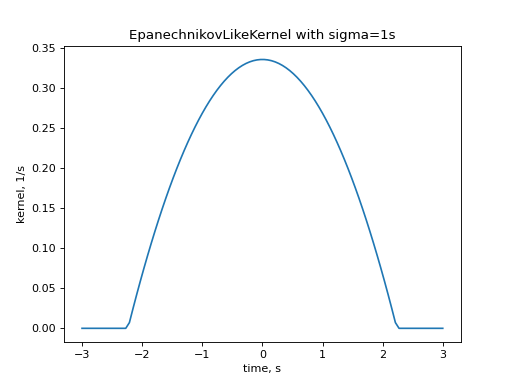elephant.kernels.EpanechnikovLikeKernel¶
- class elephant.kernels.EpanechnikovLikeKernel(sigma, invert=False)[source]¶
Class for Epanechnikov-like kernels.
\[\begin{split}K(t) = \left\{\begin{array}{ll} (3 /(4 d)) (1 - (t / d)^2), & |t| < d \\ 0, & |t| \geq d \end{array} \right.\end{split}\]with \(d = \sqrt{5} \sigma\) being the half width of the kernel.
The Epanechnikov kernel under full consideration of its axioms has a half width of \(\sqrt{5}\). Ignoring one axiom also the respective kernel with half width = 1 can be called Epanechnikov kernel. However, arbitrary width of this type of kernel is here preferred to be called ‘Epanechnikov-like’ kernel.
The parameter invert has no effect on symmetric kernels.
Examples
from elephant import kernels import quantities as pq import numpy as np import matplotlib.pyplot as plt time_array = np.linspace(-3, 3, num=100) * pq.s kernel = kernels.EpanechnikovLikeKernel(sigma=1*pq.s) kernel_time = kernel(time_array) plt.plot(time_array, kernel_time) plt.title("EpanechnikovLikeKernel with sigma=1s") plt.xlabel("time, s") plt.ylabel("kernel, 1/s") plt.show()
(
Source code,png,hires.png,pdf)
- __init__(sigma, invert=False)¶
Methods
__init__(sigma[, invert])boundary_enclosing_area_fraction(fraction)Calculates the boundary \(b\) so that the integral from \(-b\) to \(b\) encloses a certain fraction of the integral over the complete kernel.
cdf(time)Cumulative Distribution Function, CDF.
icdf(fraction)Inverse Cumulative Distribution Function, ICDF, also known as a quantile.
is_symmetric()True for symmetric kernels and False otherwise (asymmetric kernels).
median_index(times)Estimates the index of the Median of the kernel.
Attributes
min_cutoffHalf width of the kernel.
